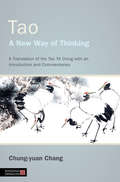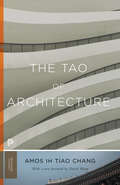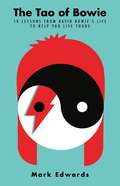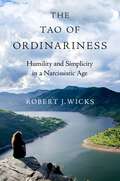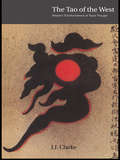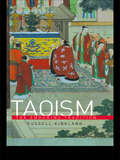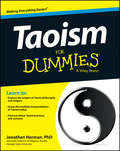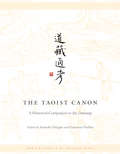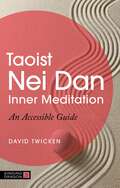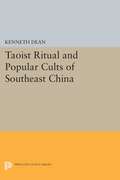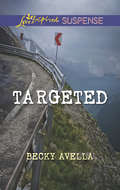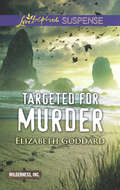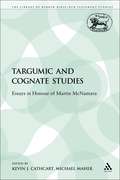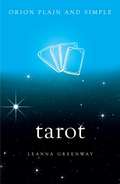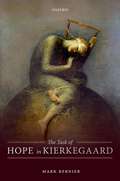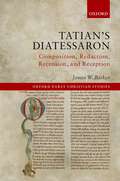- Table View
- List View
Tao - A New Way of Thinking: A Translation of the Tao Tê Ching with an Introduction and Commentaries (PDF)
by Chung-Yuan ChangThis exceptional translation of the Tao Tê Ching by Chinese scholar Chung-yuan Chang reveals the true wisdom and beauty of this ancient Chinese text. Traditionally attributed to Taoist philosopher Lao Tzu, the Tao Tê Ching remains relevant worldwide today, more than two thousand years after it was written. This translation of the Taoist text, with Chang's accompanying commentaries, illuminates the real meaning of the Tao Tê Ching and makes this Chinese classic both accessible and relevant to modern ways of thinking, without any reduction of the complex thought within its pages. Chang Chung-yuan is unique in his approach and his introduction and commentaries place the Taoist text in the context of Western metaphysics, making reference to Heidegger, Hegel, Schopenhauer, Jung, Plato, Kant and Nietzsche, as well as capturing the context within which Taoism came to the West. Tao: A New Way of Thinking will be fascinating to anyone with an interest in Taoism and will be particularly appealing to those interested in comparative philosophy.
The Tao of Architecture
by Amos Ih Chang David WangFrank Lloyd Wright first noted the affinity between modern Western architecture and the philosophy of the ancient Chinese writer Laotzu. In this classic work, Amos Ih Tiao Chang expands on that idea, developing the parallel with the aid of architectural drawings and Chinese paintings. Now with a new foreword by David Wang, this book reveals the vitality of intangible, or negative, elements. Chang writes that these qualities make architectonic forms "come alive, become human, naturally harmonize with one another, and enable us to experience them with human sensibility." The Tao of Architecture continues to be essential reading for understanding the intersection between architecture and philosophy.
The Tao of Architecture
by Amos Ih Chang David WangFrank Lloyd Wright first noted the affinity between modern Western architecture and the philosophy of the ancient Chinese writer Laotzu. In this classic work, Amos Ih Tiao Chang expands on that idea, developing the parallel with the aid of architectural drawings and Chinese paintings. Now with a new foreword by David Wang, this book reveals the vitality of intangible, or negative, elements. Chang writes that these qualities make architectonic forms "come alive, become human, naturally harmonize with one another, and enable us to experience them with human sensibility." The Tao of Architecture continues to be essential reading for understanding the intersection between architecture and philosophy.
The Tao of Bowie: 10 Lessons from David Bowie's Life to Help You Live Yours
by Mark EdwardsWhat would David Bowie do?When life gets tough, who can we turn to for help? Who will help us find happiness, meaning and purpose? The Tao of Bowie suggests that we turn to David Bowie for guidance - and use his amazing journey through life as a map to help us navigate our own.Buddhism was central to David Bowie's life, but he was a wide-ranging thinker who also drew meaning from other sources including Jungian psychology, Nietzschean philosophy and Gnosticism. The Tao of Bowie condenses these concepts - the ideas that inspired and supported Bowie throughout his life and career - into ten powerful lessons, each with a series of exercises, meditations and techniques to encourage readers to apply these learnings to their own lives. The Tao of Bowie will help readers understand who they really are, clarify their purpose in life, manage their emotions and cope with setbacks and change. This fresh approach to the search for spirituality and happiness unites the perennial human quest for answers with the extraordinary mind and unique career of one of the most important cultural figures of the past half-century.
The Tao of Ordinariness: Humility and Simplicity in a Narcissistic Age
by Robert J. WicksThis book is an invitation to come home to your authentic self in a world that is frequently mesmerized by "spin," narcissism, fantasy, and exhibitionism. Psychology and classic wisdom literature have, in various ways, long recognized the value for simply becoming who you are (i.e., ordinariness). However, this call is becoming increasingly drowned out by the many other voices that emphasize publicity and image-making over authenticity and humility. Renowned therapist and author Robert Wicks has written The Tao of Ordinariness as a way of beginning to address these tendencies in contemporary society. In this new countercultural work, the strength and joy of exploring who you are - and proceeding to share yourself with others in a way that they too can reclaim themselves - is revisited from a range of vantage points. The author specifically reexamines themes of humility, simplicity, letting go, self-awareness, "alonetime," resilience, and mentoring. In an era when people increasingly measure self-worth by external measures, such as the number of likes and views and followers on social media feeds (which have many individuals chasing impossible fantasies and living with a constant fear of "missing out"), Wicks offers a return to your authentic self.
The Tao of Ordinariness: Humility and Simplicity in a Narcissistic Age
by Robert J. WicksThis book is an invitation to come home to your authentic self in a world that is frequently mesmerized by "spin," narcissism, fantasy, and exhibitionism. Psychology and classic wisdom literature have, in various ways, long recognized the value for simply becoming who you are (i.e., ordinariness). However, this call is becoming increasingly drowned out by the many other voices that emphasize publicity and image-making over authenticity and humility. Renowned therapist and author Robert Wicks has written The Tao of Ordinariness as a way of beginning to address these tendencies in contemporary society. In this new countercultural work, the strength and joy of exploring who you are - and proceeding to share yourself with others in a way that they too can reclaim themselves - is revisited from a range of vantage points. The author specifically reexamines themes of humility, simplicity, letting go, self-awareness, "alonetime," resilience, and mentoring. In an era when people increasingly measure self-worth by external measures, such as the number of likes and views and followers on social media feeds (which have many individuals chasing impossible fantasies and living with a constant fear of "missing out"), Wicks offers a return to your authentic self.
The Tao of the West: Western Tranformations of Taoist Thought
by J.J. ClarkeIn this book, J.J. Clarke shows us how Taoist texts, ideas, and practices have been assimilated within a whole range of Western ideas and agendas. We see how Chinese thinkers such as Lao-tzu and Chuang tzu, along with practices such as Feng Shui and Tai Chi, have been used as a key Western inspiration in religion, philosophy, ethics, politics, ecology and health.The Tao of the West not only provides a fascinating introduction to Taoism, it also offers a timely insight into the history of the West's encounter with this ancient tradition, and into the issues arising from inter-cultural dialogue. Anyone interested in understanding the key influence Taoism has had on the West will welcome and embrace this book.
The Tao of the West: Western Tranformations of Taoist Thought
by J.J. ClarkeIn this book, J.J. Clarke shows us how Taoist texts, ideas, and practices have been assimilated within a whole range of Western ideas and agendas. We see how Chinese thinkers such as Lao-tzu and Chuang tzu, along with practices such as Feng Shui and Tai Chi, have been used as a key Western inspiration in religion, philosophy, ethics, politics, ecology and health.The Tao of the West not only provides a fascinating introduction to Taoism, it also offers a timely insight into the history of the West's encounter with this ancient tradition, and into the issues arising from inter-cultural dialogue. Anyone interested in understanding the key influence Taoism has had on the West will welcome and embrace this book.
Taoism: The Enduring Tradition
by Russell KirklandThis clear and reliable introduction to Taoism (also known as Daoism) brings a fresh dimension to a tradition that has found a natural place in Western society. Examining Taoist sacred texts together with current scholarship, it surveys Taoism's ancient roots, contemporary heritage and role in daily life.From Taoism's spiritual philosophy to its practical perspectives on life and death, self-cultivation, morality, society, leadership and gender, Russell Kirkland's essential guide reveals the real contexts behind concepts such as Feng Shui and Tai Chi.
Taoism: The Enduring Tradition
by Russell KirklandThis clear and reliable introduction to Taoism (also known as Daoism) brings a fresh dimension to a tradition that has found a natural place in Western society. Examining Taoist sacred texts together with current scholarship, it surveys Taoism's ancient roots, contemporary heritage and role in daily life.From Taoism's spiritual philosophy to its practical perspectives on life and death, self-cultivation, morality, society, leadership and gender, Russell Kirkland's essential guide reveals the real contexts behind concepts such as Feng Shui and Tai Chi.
Taoism For Dummies
by Jonathan HermanThe definitive guide to understanding Taoism—no matter your background or faith Lao Tzu's Tao Te Ching is the second most translated book in the world, and the practice of religious Taoism is on the rise in China, where adherents currently number in the hundreds of millions. Yet there remains a remarkable lack of reliable information about Taoism for curious westerners. Taoism For Dummies provides comprehensive coverage of Taoism's origins in China's Chou Dynasty, its underlying quietist principles, its emergence as a major religion, various interpretation of its core texts, including both Eastern and Western interpretations, key Taoist concepts, and much more. It also provides a fascinating glimpse of Taoism in contemporary China. The ideal guide for readers interested in this influential religion, as well as those taking an introductory course on Taoism or Chinese Religion A valuable source of insight for those with an interest in modern Chinese culture and beliefs
Taoism For Dummies
by Jonathan HermanThe definitive guide to understanding Taoism—no matter your background or faith Lao Tzu's Tao Te Ching is the second most translated book in the world, and the practice of religious Taoism is on the rise in China, where adherents currently number in the hundreds of millions. Yet there remains a remarkable lack of reliable information about Taoism for curious westerners. Taoism For Dummies provides comprehensive coverage of Taoism's origins in China's Chou Dynasty, its underlying quietist principles, its emergence as a major religion, various interpretation of its core texts, including both Eastern and Western interpretations, key Taoist concepts, and much more. It also provides a fascinating glimpse of Taoism in contemporary China. The ideal guide for readers interested in this influential religion, as well as those taking an introductory course on Taoism or Chinese Religion A valuable source of insight for those with an interest in modern Chinese culture and beliefs
The Taoist Canon: A Historical Companion to the Daozang
by Kristofer Schipper Franciscus VerellenTaoism remains the only major religion whose canonical texts have not been systematically arranged and made available for study. This long-awaited work, a milestone in Chinese studies, catalogs and describes all existing texts within the Taoist canon. The result will not only make the entire range of existing Taoist texts accessible to scholars of religion, it will open up a crucial resource in the study of the history of China. The vast literature of the Taoist canon, or Daozang, survives in a Ming Dynasty edition of some fifteen hundred different texts. Compiled under imperial auspices and completed in 1445—with a supplement added in 1607—many of the books in the Daozang concern the history, organization, and liturgy of China's indigenous religion. A large number of works deal with medicine, alchemy, and divination. If scholars have long neglected this unique storehouse of China's religious traditions, it is largely because it was so difficult to find one's way within it. Not only was the rationale of its medieval classification system inoperable for the many new texts that later entered the Daozang, but the system itself was no longer understood by the Ming editors; hence the haphazard arrangement of the canon as it has come down to us. This new work sets out the contents of the Daozang chronologically, allowing the reader to follow the long evolution of Taoist literature. Lavishly illustrated, the first volume ranges from antiquity through the Middle Ages, while the second spans the modern period. Within this frame, texts are grouped by theme and subject. Each one is the subject of a historical abstract that identifies the text's contents, date of origin, and author. Throughout the first two volumes, introductions outline the evolution of Taoism and its spiritual heritage. A third volume offering biographical sketches of frequently mentioned Taoists, multiple indexes, and an extensive bibliography provides critical tools for navigating this guide to one of the fundamental aspects of Chinese culture.
The Taoist Canon: A Historical Companion to the Daozang
Taoism remains the only major religion whose canonical texts have not been systematically arranged and made available for study. This long-awaited work, a milestone in Chinese studies, catalogs and describes all existing texts within the Taoist canon. The result will not only make the entire range of existing Taoist texts accessible to scholars of religion, it will open up a crucial resource in the study of the history of China. The vast literature of the Taoist canon, or Daozang, survives in a Ming Dynasty edition of some fifteen hundred different texts. Compiled under imperial auspices and completed in 1445—with a supplement added in 1607—many of the books in the Daozang concern the history, organization, and liturgy of China's indigenous religion. A large number of works deal with medicine, alchemy, and divination. If scholars have long neglected this unique storehouse of China's religious traditions, it is largely because it was so difficult to find one's way within it. Not only was the rationale of its medieval classification system inoperable for the many new texts that later entered the Daozang, but the system itself was no longer understood by the Ming editors; hence the haphazard arrangement of the canon as it has come down to us. This new work sets out the contents of the Daozang chronologically, allowing the reader to follow the long evolution of Taoist literature. Lavishly illustrated, the first volume ranges from antiquity through the Middle Ages, while the second spans the modern period. Within this frame, texts are grouped by theme and subject. Each one is the subject of a historical abstract that identifies the text's contents, date of origin, and author. Throughout the first two volumes, introductions outline the evolution of Taoism and its spiritual heritage. A third volume offering biographical sketches of frequently mentioned Taoists, multiple indexes, and an extensive bibliography provides critical tools for navigating this guide to one of the fundamental aspects of Chinese culture.
The Taoist Canon, Volume 2 (Replacement Volume): A Historical Companion to the Daozang
by Kristofer Marinus Schipper Franciscus VerellenTaoism remains the only major religion whose canonical texts have not been systematically arranged and made available for study. This long-awaited work, a milestone in Chinese studies, catalogs and describes all existing texts within the Taoist canon. The result will not only make the entire range of existing Taoist texts accessible to scholars of religion, it will open up a crucial resource in the study of the history of China. The vast literature of the Taoist canon, or Daozang, survives in a Ming Dynasty edition of some fifteen hundred different texts. Compiled under imperial auspices and completed in 1445—with a supplement added in 1607—many of the books in the Daozang concern the history, organization, and liturgy of China's indigenous religion. A large number of works deal with medicine, alchemy, and divination. If scholars have long neglected this unique storehouse of China's religious traditions, it is largely because it was so difficult to find one's way within it. Not only was the rationale of its medieval classification system inoperable for the many new texts that later entered the Daozang, but the system itself was no longer understood by the Ming editors; hence the haphazard arrangement of the canon as it has come down to us. This new work sets out the contents of the Daozang chronologically, allowing the reader to follow the long evolution of Taoist literature. Lavishly illustrated, the first volume ranges from antiquity through the Middle Ages, while the second spans the modern period. Within this frame, texts are grouped by theme and subject. Each one is the subject of a historical abstract that identifies the text's contents, date of origin, and author. Throughout the first two volumes, introductions outline the evolution of Taoism and its spiritual heritage. A third volume offering biographical sketches of frequently mentioned Taoists, multiple indexes, and an extensive bibliography provides critical tools for navigating this guide to one of the fundamental aspects of Chinese culture.
Taoist Nei Dan Inner Meditation: An Accessible Guide
by David TwickenBased on the ancient wisdom of the Taoist tradition, this book translates cryptic, alchemical language into an accessible and straightforward guide to Nei Dan using everyday terms. Focussing on breath work, meditations, and series of movements founded in qi gong, this book aids you in attuning to your true nature and nurtures balance and wellbeing in your physical, spiritual, and psycho-emotional health.Through an integration of Nei Dan inner meditations, this book explains the art of letting go of our traumas, imprints, and conditioning and encourages a reattachment of the self to our true natures. Taoist Nei Dan Inner-Meditation builds upon David Twicken's full collection and provides a comprehensive system of Nei Dan meditation for all professionals working with Chinese Medicine and anyone interested in this form of meditation.
Taoist Nei Dan Inner Meditation: An Accessible Guide
by David TwickenBased on the ancient wisdom of the Taoist tradition, this book translates cryptic, alchemical language into an accessible and straightforward guide to Nei Dan using everyday terms. Focussing on breath work, meditations, and series of movements founded in qi gong, this book aids you in attuning to your true nature and nurtures balance and wellbeing in your physical, spiritual, and psycho-emotional health.Through an integration of Nei Dan inner meditations, this book explains the art of letting go of our traumas, imprints, and conditioning and encourages a reattachment of the self to our true natures. Taoist Nei Dan Inner-Meditation builds upon David Twicken's full collection and provides a comprehensive system of Nei Dan meditation for all professionals working with Chinese Medicine and anyone interested in this form of meditation.
Taoist Ritual and Popular Cults of Southeast China
by Kenneth DeanMost commentators imagine contemporary China to be monolithic, atheistic, and materialist, and wholly divorced from its earlier customs, but Kenneth Dean combines evidence from historical texts and extensive fieldwork to reveal an entirely different picture. Since 1979, when the Chinese government relaxed some of its most stringent controls on religion, villagers in the isolated areas of Southeast China have maintained an "underground" effort to restore traditional rituals and local cults.Originally published in 1993.The Princeton Legacy Library uses the latest print-on-demand technology to again make available previously out-of-print books from the distinguished backlist of Princeton University Press. These editions preserve the original texts of these important books while presenting them in durable paperback and hardcover editions. The goal of the Princeton Legacy Library is to vastly increase access to the rich scholarly heritage found in the thousands of books published by Princeton University Press since its founding in 1905.
Targeted: Duty Bound Guardian Targeted Presumed Guilty (Mills And Boon Love Inspired Suspense Ser.)
by Becky AvellaMARKED FOR MURDER
Targeted For Murder: High-risk Reunion Targeted For Murder Deadly Setup (Wilderness, Inc. #1)
by Elizabeth GoddardMOUNTAIN PURSUIT
Targumic and Cognate Studies: Essays in Honour of Martin McNamara (The Library of Hebrew Bible/Old Testament Studies)
by Kevin J. Cathcart Michael MaherThis volume draws together essays by fourteen international scholars in the field of Aramaic and Syriac studies. It is published to pay fitting honour to Professor Martin McNamara, who has contributed so much to Targumic studies for almost forty years. The contributions in this collection reflect his interests in the study of the Targums, the development of the Aramaic language and early Jewish and Christian literature. Many of the contributors to this volume have worked with Professor McNamara in preparing volumes for the Aramaic Bible series, to which he has devoted so much time and energy.
Tarot, Orion Plain and Simple: The Only Book You'll Ever Need (Plain and Simple)
by Leanna GreenawayA practical guide on how to master the art of reading cards.Tarot is a popular form of divination that has been used for centuries. By following the simple guidelines set out in this book, you will come to understand how easy it is to master the art of reading cards. Many people struggle with the many different tarot books available today ? they can be difficult for the novice to follow, and many present differing interpretations of the cards. This practical guide brings tarot into the 21st century, making the card meanings relevant and easy to understand and follow.Tarot, Orion Plain & Simple offers modern and up-to-date interpretations for all 78 cards. Once you know these basics, you'll soon progress on to more advanced and complex tarot books. Throughout this useful book, Leanna Greenaway discusses various card groups for interpretation, focusing mainly on the Celtic cross spread.
The Task of Hope in Kierkegaard
by Mark BernierPhilosophers of religion are often caught up with the epistemic justification of their religious beliefs, rather than the qualities of the religious life that make it valuable. Mark Bernier argues that hope is one of the most important of such qualities, and is an essential thread that connects despair, faith, and the self. The Task of Hope in Kierkegaard reconstructs Kierkegaard's theory of hope, which involves the distinction between mundane and authentic hope, and makes three principal claims. Firstly, while despair involves the absence of hope, a rejection of oneself, and a turn away from one's relation to God, despair is fundamentally an unwillingness to hope. This unwillingness is directed toward authentic hope, conceived of by Kierkegaard as an expectation for the possibility of the good. Secondly, hope is not simply an ancillary activity of the self; rather, the task of becoming a self is essentially constituted by hope. Thus, when in despair one is unwilling to hope, one is in fact rejecting one's task of becoming a self. Thirdly, faith stands in opposition to despair precisely because it is a willingness to hope. An essential role of faith is to secure the ground for hope, and in this way faith secures the ground for the self. In short, authentic hope (what Kierkegaard calls spiritual hope) is not merely a fringe element, but is essential to Kierkegaard's project of the self.
Tatian's Diatessaron: Composition, Redaction, Recension, and Reception (Oxford Early Christian Studies)
by James W. BarkerIn the late-second century, Tatian the Assyrian constructed a new Gospel by intricately harmonizing Matthew, Mark, Luke, and John. Tatian's work became known as the Diatessaron, since it was derived 'out of the four' eventually canonical Gospels. Though it circulated widely for centuries, the Diatessaron disappeared in antiquity. Nevertheless, numerous ancient and medieval harmonies survive in various languages. Some texts are altogether independent of the Diatessaron, while others are definitely related. Yet even Tatian's known descendants differ in large and small ways, so attempts at reconstruction have proven confounding. In this book James W. Barker forges a new path in Diatessaron studies. Covering the widest array of manuscript evidence to date, Tatian's Diatessaron reconstructs the compositional and editorial practices by which Tatian wrote his Gospel. By sorting every extant witnesses according to its narrative sequence, the macrostructure of Tatian's Gospel becomes clear. Despite many shared agreements, there remain significant divergences between eastern and western witnesses. This book argues that the eastern ones preserve Tatian's order, whereas the western texts descend from a fourth-century recension of the Diatessaron. Victor of Capua and his scribe used the recension to produce the Latin Codex Fuldensis in the sixth century. More controversially, Barker offers new evidence that late medieval texts such as the Middle Dutch Stuttgart harmony independently preserve traces of the western recension. This study uncovers the composition and reception history behind one of early Christianity's most elusive texts.
Tatian's Diatessaron: Composition, Redaction, Recension, and Reception (Oxford Early Christian Studies)
by James W. BarkerIn the late-second century, Tatian the Assyrian constructed a new Gospel by intricately harmonizing Matthew, Mark, Luke, and John. Tatian's work became known as the Diatessaron, since it was derived 'out of the four' eventually canonical Gospels. Though it circulated widely for centuries, the Diatessaron disappeared in antiquity. Nevertheless, numerous ancient and medieval harmonies survive in various languages. Some texts are altogether independent of the Diatessaron, while others are definitely related. Yet even Tatian's known descendants differ in large and small ways, so attempts at reconstruction have proven confounding. In this book James W. Barker forges a new path in Diatessaron studies. Covering the widest array of manuscript evidence to date, Tatian's Diatessaron reconstructs the compositional and editorial practices by which Tatian wrote his Gospel. By sorting every extant witnesses according to its narrative sequence, the macrostructure of Tatian's Gospel becomes clear. Despite many shared agreements, there remain significant divergences between eastern and western witnesses. This book argues that the eastern ones preserve Tatian's order, whereas the western texts descend from a fourth-century recension of the Diatessaron. Victor of Capua and his scribe used the recension to produce the Latin Codex Fuldensis in the sixth century. More controversially, Barker offers new evidence that late medieval texts such as the Middle Dutch Stuttgart harmony independently preserve traces of the western recension. This study uncovers the composition and reception history behind one of early Christianity's most elusive texts.
